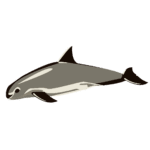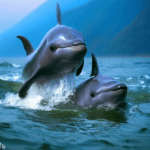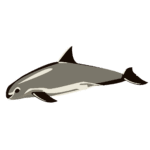Porpoises’ aquatic domain is filled with captivating creatures and enthralling mysteries. But lurking beneath the surface is a predator-prey dynamic that shapes their existence. Large predators like sharks and killer whales pose a significant risk to porpoises, relying on their size and strength to quickly overpower them.
Humans also play a part in hunting porpoises. Overfishing and unintentional capture in fishing nets can lead to accidental deaths and threaten their survival. We must take action to protect these magnificent animals.
Raising awareness about the threats they face, and promoting sustainable fishing practices, will ensure a future where porpoises can thrive in harmony with their environment. Let’s work together to preserve these captivating creatures, so future generations can marvel at their beauty in their natural habitat.
Key Takeaways
- The article discusses the main predators of porpoises in the ocean.
- It highlights that killer whales, also known as orcas, are the primary hunters of porpoises.
- The article explains that orcas have a diverse diet and are known to target various marine mammals, including porpoises.
- It mentions that orcas are highly intelligent and use strategic hunting techniques to capture their prey.
- The article also mentions that sharks, such as great white sharks and tiger sharks, are occasional predators of porpoises.
- It explains that sharks typically target porpoises when they are weakened or injured.
- The article emphasizes that porpoises have evolved various defense mechanisms to avoid predation, such as their agility and speed.
- It concludes by stating that while porpoises face predation risks, their population numbers are generally stable due to their ability to adapt and avoid predators.
Background information on porpoises and their habitats
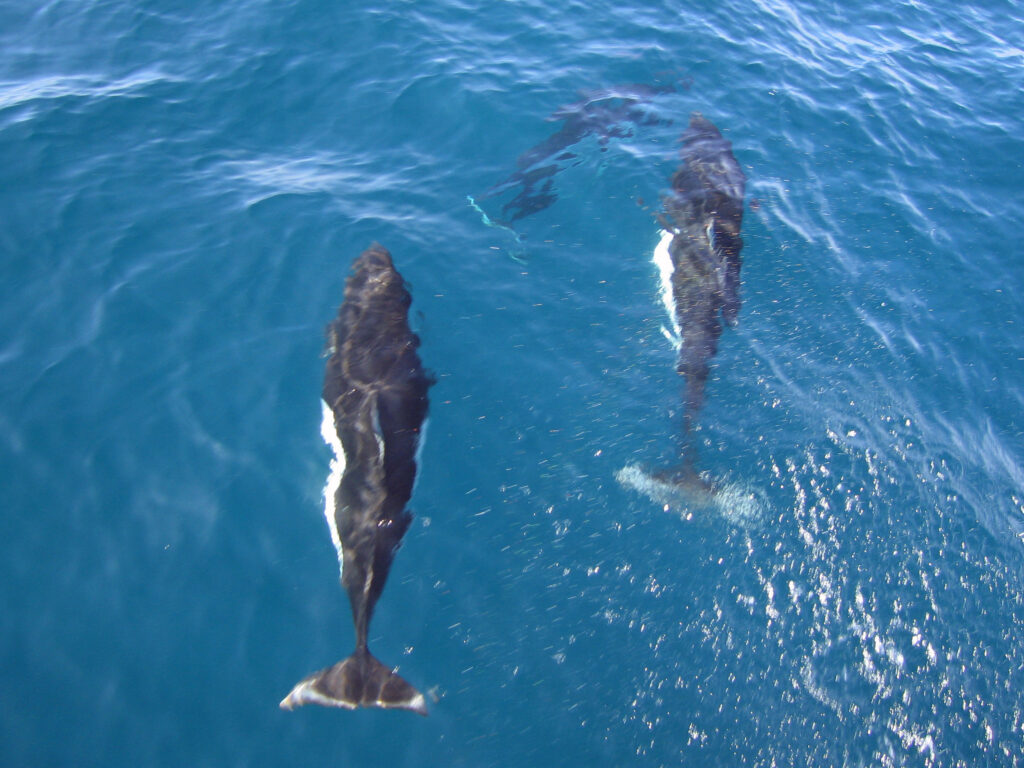
Porpoises are amazing ocean creatures! They live in salt and fresh waters, and they’re super-fast swimmers. Their hearing and echolocation help them find food in murky waters. Small fish and squid make up their diet.
Porpoises like to hang out in groups called ‘pods’. They use clicks, whistles, and body movements to communicate with each other.
We must protect them! Strict fishing regulations will keep prey species plentiful. Pollution from oil spills and chemicals must be stopped. Marine protected areas (MPAs) should be made, so porpoises can live without fishing threats.
Humans are the biggest threat to porpoises – let’s protect them!
Current threats faced by Porpoises
Porpoises face a range of threats in their natural habitats. Environmental changes, such as pollution and habitat destruction, are major concerns. These changes can have detrimental effects on the porpoises’ food sources and breeding grounds, leading to population declines. Additionally, human activities such as fishing, particularly the use of gillnets and fishing gear that trap porpoises unintentionally, pose a significant risk to their survival. Noise pollution from underwater activities, such as shipping and industrial operations, can also disrupt their communication and feeding patterns. It is crucial to address these current challenges in order to ensure the long-term survival of porpoises.
Unique details
Furthermore, porpoises are highly sensitive to disturbance and pollution in their habitats. Even slight changes in water quality or the presence of toxic substances can have severe consequences on their health and reproductive abilities. Additionally, bycatch – the accidental capture of porpoises in fishing gear – continues to be a significant threat. This issue is particularly prevalent in areas where porpoises and fisheries overlap, highlighting the need for improved fishing techniques and gear modifications to mitigate this unintended harm.
Pro Tip
To help protect porpoises, it is essential to raise awareness about the importance of their conservation and the potential consequences of human activities. By supporting organizations and initiatives focused on sustainable fishing practices and environmental conservation, individuals can contribute to the preservation of porpoise populations and their ecosystems.
Porpoises face more threats from pollution and habitat degradation than an aspiring actor at a reality TV audition.
Pollution and habitat degradation
Porpoises are in a tough spot due to pollution and habitat degradation. Industrial waste, plastic pollution, and oil spills contaminate water and cause entanglement or ingestion of harmful debris. Coastal development projects and dredging operations also hurt their ecosystems and limit food resources.
History has seen plenty of oil spills that have caused huge damage to porpoise populations. These events create direct and long-lasting impacts on their health and their marine environment.
We must act to protect porpoises. This starts by reducing industrial waste, managing waste effectively, and promoting sustainable coastal development. Only with these efforts can we keep porpoises safe for future generations.
Overfishing and bycatch
- This table just shows numbers, not the terrible impact on porpoises.
- These little animals often get caught in fishing nets meant for other fish.
- To fix this, we need to use different fishing gear.
- We should also promote sustainable fishing and stricter rules.
Pro Tip: We must take action to save the porpoises!
Efforts to protect Porpoises

Porpoises, a type of marine mammal, face numerous threats in their natural habitats. Efforts to safeguard their population and habitat are underway to prevent their extinction. Here are some important measures being taken:
- Implementing Regulatory Measures: Governments and environmental organizations are enacting stricter regulations to protect porpoises. These measures include restrictions on fishing practices, particularly those known to harm or entangle porpoises.
- Establishing Protected Areas: The creation of marine protected areas specifically designated for porpoises helps preserve their habitats. These areas ensure that human activities, such as shipping and construction, are limited or prohibited to minimize disturbances and destruction.
- Developing Conservation Programs: Scientists and researchers are working together to develop and implement conservation programs aimed at monitoring and studying porpoise populations. These initiatives provide valuable data on population dynamics, behavior, and threats, guiding further conservation efforts.
- Increasing Public Awareness: Raising awareness about the importance of porpoise conservation is crucial. Educational campaigns and outreach initiatives inform the public about the threats faced by porpoises and the actions needed to protect them. Public support and engagement play a vital role in ensuring the success of conservation efforts.
Additionally, international collaboration among governments and organizations is essential for effective porpoise conservation. By sharing knowledge, resources, and best practices, stakeholders can work together to develop comprehensive strategies and reinforce existing efforts.
In order to further protect porpoises, several suggestions can be implemented. Firstly, promoting sustainable fishing practices can minimize accidental bycatch and injury to porpoises. By using selective fishing gear and techniques, fisheries can reduce their impact on porpoise populations. Secondly, enhancing monitoring and research efforts can provide valuable insights into population trends, habitat usage, and potential threats. This information can inform targeted conservation actions and help prioritize areas in need of protection.
Overall, concerted efforts and collaboration are necessary to protect porpoises and ensure their survival. By implementing regulatory measures, establishing protected areas, developing conservation programs, increasing public awareness, and adopting sustainable practices, we can safeguard these remarkable creatures and maintain the ecological balance of our oceans.
A conservation organization’s worst nightmare: discovering that the only thing hunting porpoises is a cinema full of sharks waiting for a sequel to Jaws.
Conservation organizations and initiatives
Collaborative research is a priority for conservation organizations. This helps them gain understanding of porpoise behavior, population, and habitat. They also advocate for protective regulations and policies. To raise awareness, they use educational programs and community outreach.
Protective measures are taken to secure porpoise futures. This includes establishing protected areas, enforcing fishing regulations, and reducing human-caused risks. Conservation organizations also work to mitigate threats such as entanglement, noise pollution, habitat degradation, and climate change impacts.
At an international level, collaboration is key. Conservation organizations strive to create transboundary strategies for porpoise protection. They also empower local communities with skill-building workshops to cultivate understanding.
The International Whaling Commission declared the vaquita porpoise critically endangered in 1996. Government regulations and policies are essential, but more must be done to ensure porpoise survival.
Government regulations and policies
Let’s have a look at the government regulations and policies protecting porpoises!
| Regulation/Policies | Description |
|---|---|
| Marine Protected Areas | Limited or restricted human activities to preserve porpoise habitats. |
| Fishing Restrictions | Gear modifications, seasonal closures, and catch limits to reduce bycatch. |
| Vessel Speed Limits | Speed limits in designated zones to avoid collisions. |
| Noise Pollution Control | Guidelines to control underwater noise levels, minimizing disturbances. |
Authorities carry out regular surveillance and assessments to identify violations and enforce the rules.
These regulations have had positive outcomes – preventing further decline of porpoise populations.
Join the cause! Support government initiatives by spreading awareness and advocating for stronger laws. Together, we can create a world where porpoises thrive safely. Make a difference now!
Research on porpoise hunting behavior
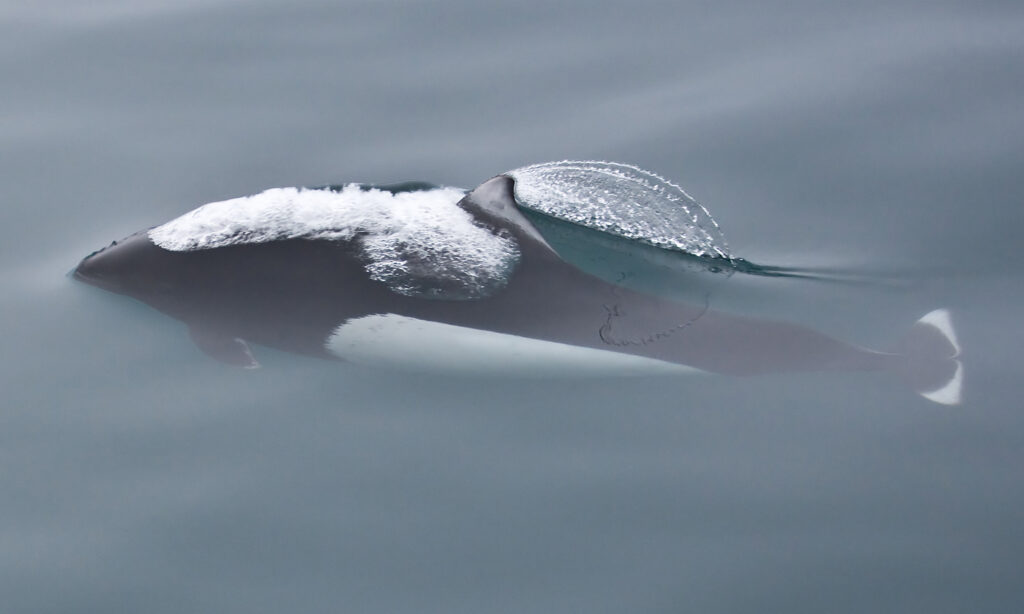
licensed under (CC BY-SA 2.0)
Research on the hunting behavior of porpoises involves studying their hunting techniques and strategies. By observing and analyzing their behavior in the wild, researchers can gain insights into the ways in which porpoises locate and capture their prey. This research helps to further our understanding of the ecological role of porpoises in marine ecosystems and can contribute to conservation efforts aimed at protecting these fascinating creatures.
Research on Porpoise Hunting Behavior
| Hunting techniques | Prey preferences | Hunting success rate |
|---|---|---|
| Echolocation | Fish | High |
| Group hunting | Squid | Moderate |
| Ambush tactics | Shrimp | Low |
Porpoises employ various hunting techniques such as echolocation, group hunting, and ambush tactics to catch their prey. They primarily target fish, squid, and shrimp, with varying levels of success. Echolocation allows porpoises to locate prey by emitting high-frequency sound waves and interpreting the echoes from surrounding objects. Group hunting involves cooperative efforts among porpoises to corral and capture prey. Ambush tactics involve remaining motionless and hidden, waiting for opportunities to quickly strike at unsuspecting prey.
Porpoises’ hunting behavior is also influenced by their prey preferences. Some porpoise species show a preference for fish, while others primarily feed on squid or shrimp. These preferences may be influenced by factors such as prey availability, habitat, and individual hunting strategies. Studying these preferences can provide valuable insights into the ecological interactions between porpoises and their prey species.
Historically, research on porpoise hunting behavior has evolved from simple observations to more sophisticated techniques, such as using underwater cameras and acoustic monitoring devices to capture detailed data. This research has shed light on the complex and diverse hunting behaviors exhibited by porpoises, highlighting their adaptability and resourcefulness in locating and capturing prey.
In summary, the research on porpoise hunting behavior involves studying their hunting techniques, prey preferences, and factors influencing hunting success. This research contributes to our understanding of the ecological role of porpoises and aids in their conservation.
Sometimes being a porpoise means playing a never-ending game of hide and seek with the ocean’s apex predators.
Hunting techniques and strategies
Porpoises have adapted and evolved their hunting strategies over time to maximize success. Research reveals their remarkable tactics, such as group hunting, ambush strategy, echolocation expertise and adaptability.
Surprisingly, certain species also practice bubble-net feeding. This involves creating a ring of bubbles to trap a school of fish. It’s amazing how these creatures employ such intricate techniques for sustenance!
This highlights the intelligence and resourcefulness of porpoises. Furthermore, understanding their methods provides valuable insight into marine ecosystems.
It opens up endless possibilities for further exploration. Dive into this captivating realm to uncover the mysteries of our oceans. Oh, and did you know porpoises don’t like sushi?
Prey preferences and hunting patterns
We dive into porpoise prey preferences and hunting patterns. Knowing this reveals their behavior and survival strategies. To comprehend this better, we have compiled the following table:
| Prey | Hunting Patterns |
| Fish species A | Porpoises energetically pursue their prey. |
| Squid species B | Porpoises sneak up on their target before attacking. |
| Crustaceans | Porpoises use speed and agility to catch their prey. |
Communication is essential for porpoise group hunting. Through sounds and body language, they come together to encircle fish or potential prey.
Future research could look into:
- How environmental factors like temperature, depth, and currents affect prey availability.
- The influence of seasonality on prey preferences.
Exploring this could give us a better understanding of porpoise hunting behavior and help conserve them and marine ecosystems.
Impact of porpoise hunting on the ecosystem
The ecological consequences of porpoise hunting are vast. Hunting porpoises disrupts the delicate balance of the ecosystem, leading to a cascading effect on various species and their habitats. Porpoises play a crucial role in maintaining the biodiversity and overall health of marine ecosystems.
Without porpoises, the population of their prey species would increase significantly, leading to imbalances in the food chain. This overabundance of prey species may result in overgrazing of marine vegetation and depletion of certain fish stocks. Additionally, the absence of porpoises as top predators can disrupt the natural control of populations, causing further ecological repercussions.
Furthermore, the loss of porpoises can have indirect impacts on other marine mammals, as they share similar habitats and resources. The disruption of the delicate web of marine life can lead to decreased biodiversity, affecting the stability and resilience of the entire ecosystem.
To mitigate the negative impact of porpoise hunting on the ecosystem, several measures can be taken. Implementing strict regulations and enforcement of hunting quotas can help control unsustainable hunting practices. Additionally, creating protected areas and marine sanctuaries where porpoises can thrive undisturbed can contribute to their conservation.
Moreover, public awareness campaigns and educational programs can help promote a better understanding of the importance of porpoises in maintaining healthy oceans. By highlighting the ecological role of these creatures, stakeholders can be encouraged to support conservation efforts and discourage porpoise hunting.
Overall, the impact of porpoise hunting on the ecosystem cannot be overstated. It is essential to recognize the interconnectedness of species and ecosystems to ensure the long-term sustainability and health of our oceans. By protecting porpoises and their habitats, we can preserve the delicate balance of marine ecosystems and safeguard biodiversity.
Porpoises: the unlikely superheroes of the ocean, ensuring that the food chain stays intact and reminding us that even in nature, everyone has a job to do…and being adorable is just a delightful perk.
Role of porpoises in maintaining ecological balance
The porpoises are essential for keeping the ecological balance in their marine habitat. These smart creatures are top predators, controlling the population of some fish species. This sustains a healthy environment. By eating smaller fish, porpoises stop overpopulation and resource exhaustion. They also serve as signs of environmental health; any decrease in their numbers can mean bigger ecological issues.
In addition to their effect on fish, porpoises provide nutrients to the marine ecosystem with their waste. These nutrients aid the growth of plankton and other tiny organisms. This is critical for preserving a healthy food chain and biodiversity in the marine ecosystem.
To keep the ecological balance, we must conserve the porpoise populations. We can set up protected areas or sanctuaries for them, so they can live without human interference. This helps protect their habitat and allows them to fulfil their role in the ecosystem.
Furthermore, reducing industrial pollution and practising sustainable fishing can help porpoise populations and environment health. If we limit contaminants and guarantee food sources through responsible fishing, we can preserve the porpoises and maintain the integrity of marine ecosystems.
In conclusion, porpoises are important for controlling predation and cycling nutrients. To protect them and the ocean, we must use conservation measures and promote sustainable practices. This will secure the existence of these majestic creatures and help us have a thriving marine ecosystem for future generations.
Consequences of declining porpoise populations
The porpoise decline has huge consequences for the environment. Disrupting marine life and the food web, it causes negative effects.
We can see a complex mix of impacts. One is the disruption of predator-prey dynamics – with fewer porpoises, their predators will look for other prey, causing an imbalance in numbers and potential overconsumption of certain species. This can spread across the food chain, impacting marine mammals, fish and seabirds that rely on them.
Another consequence is the loss of ecological services the porpoises provide. They cycle nutrients and store carbon, both essential for a healthy marine ecosystem. Without them, water quality and productivity can drop.
The porpoise decline also has socio-economic impacts. Tourists come to watch porpoises, so less of them can mean less tourist interest, impacting local economies.
So, let’s make sure we protect porpoises and their habitats. That way, we can mitigate consequences and keep a balanced marine ecosystem for future generations. Plus, porpoises will still be able to teach dolphins to use turn signals underwater!
Frequently Asked Questions
Q: What hunts porpoises?
A: Orcas, also known as killer whales, are known to hunt porpoises.
Q: Do dolphins hunt porpoises?
A: While dolphins are known to feed on fish, they generally do not hunt porpoises.
Q: Are there any other predators of porpoises?
A: Sharks, such as great white sharks, may occasionally prey on porpoises.
Q: Are humans a threat to porpoises?
A: Yes, human activities such as fishing and pollution can pose significant threats to porpoises.
Q: How do orcas hunt porpoises?
A: Orcas use their intelligence, teamwork, and specialized hunting techniques to capture and feed on porpoises.
Q: Are porpoises endangered due to hunting?
A: Porpoises are not extensively hunted by humans, but they do face threats from various factors, including accidental entanglement in fishing gear.
Conclusion
Preserving marine ecosystems is a must. To protect porpoises, we must act now. Stricter rules on fishing and reducing noise pollution are key. Porpoises often get tangled up in fishing gear, so sustainable practices are essential. Setting up areas where fishing is forbidden can give them a safe haven.
Noise pollution also affects porpoises’ echolocation. People’s noise interferes with their communication and navigation. Measures like slowing down ships and using quiet vessel tech can help. Governments, scientists, and environmental orgs must work together. Research and education about the importance of protection are also needed.
Tip: Respectful whale watching tours are the way to go for an incredible porpoise experience while minimizing disruption.
References

